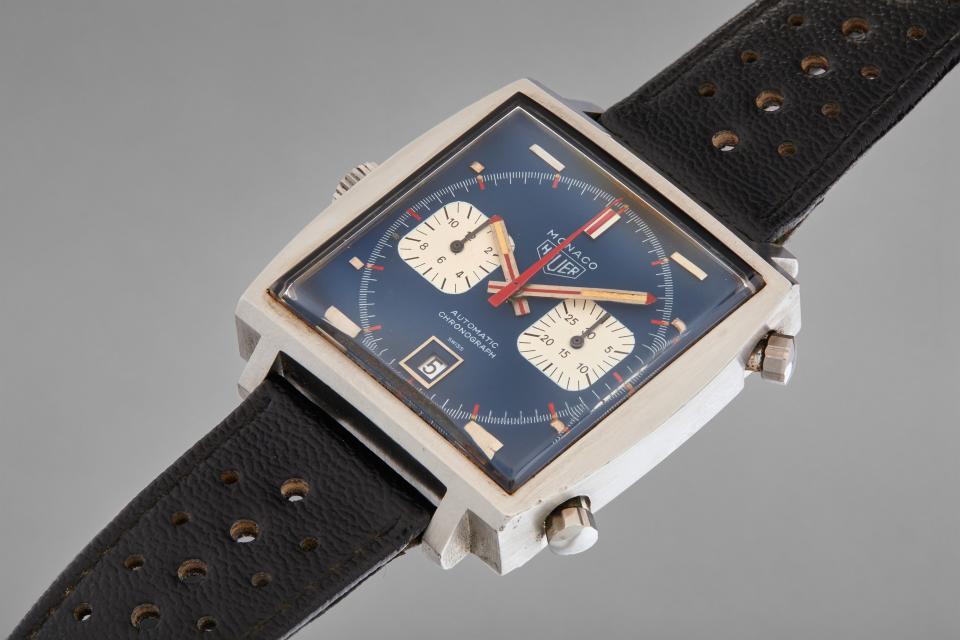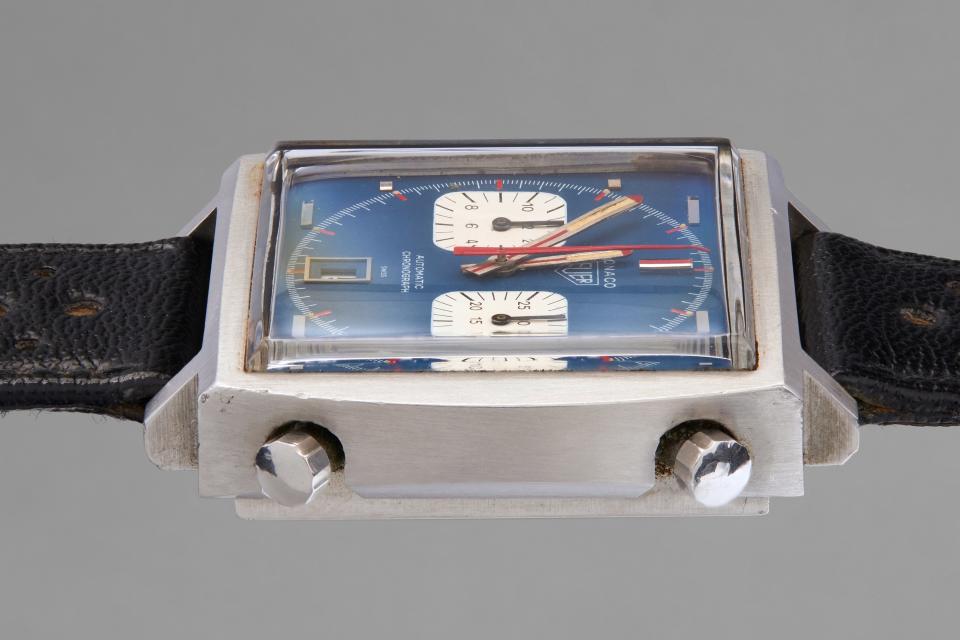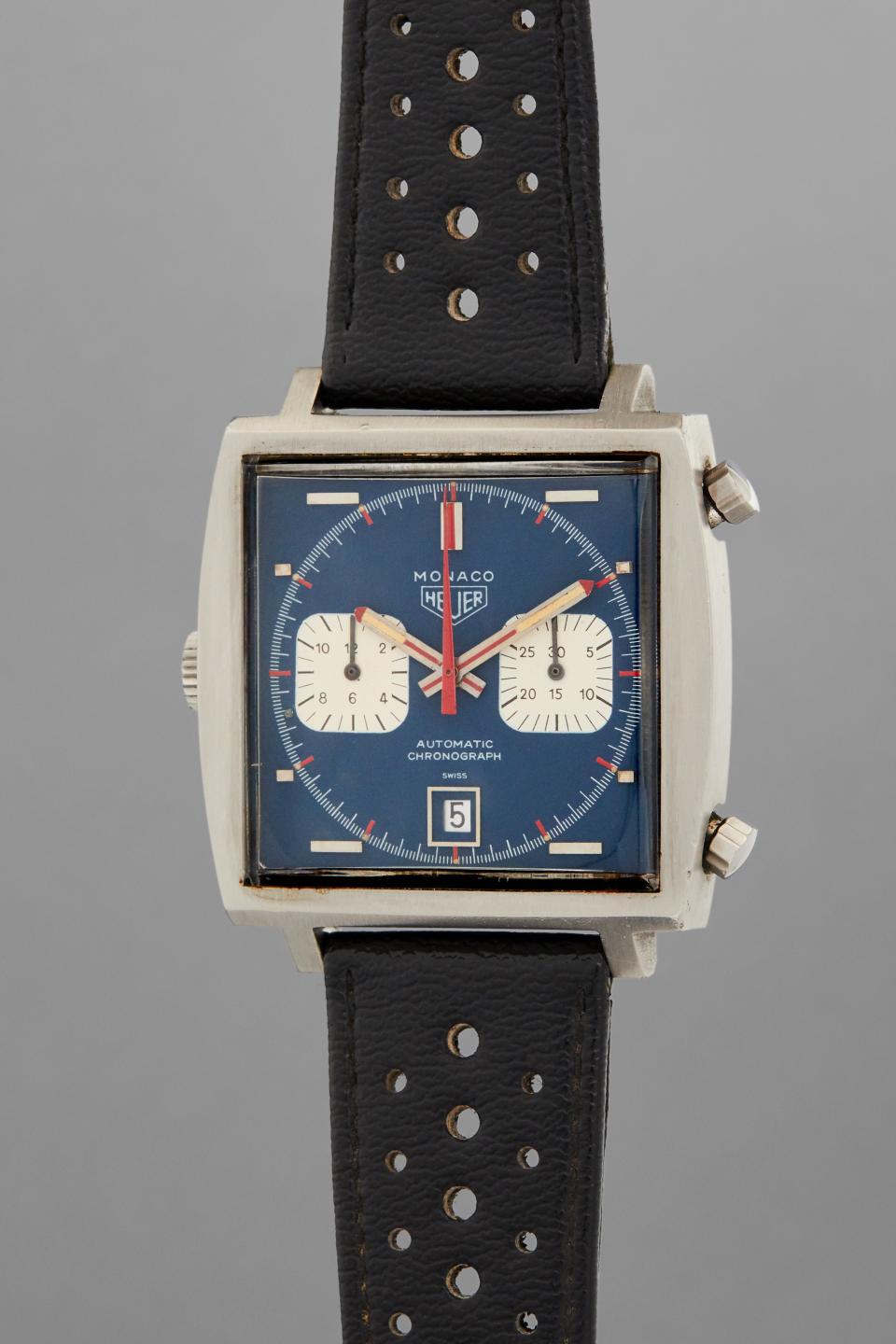Steve McQueen’s Heuer Monaco From Le Mans Races to Auction
- Oops!Something went wrong.Please try again later.
Steve McQueen picked what would become one of the most famous watches in history out of a lineup. 1971’s Le Mans was in pre-production, and McQueen, playing pro racer Michael Delaney, needed a watch. At first, and Omega Speedmaster that caught his eye, but prop manager Don Nunley reminded him of the Heuer badge on his character’s uniform, the same as most real-life competitive drivers at the time. Nothing was more important to McQueen than authenticity. So he switched gears: his character would wear a Heuer Monaco in the film.
And because authenticity was so important to McQueen, he did all his own driving for the movie. He wore the Monaco while screaming down the infamous Mulsanne straight in a Porsche 917 at almost 200 mph on the last day of filming. As filming wrapped, McQueen emerged from the 917 and his wife and two kids flocked around him. The film’s chief mechanic, Haig Altounian, was already attending to the car when McQueen walked over, took the blocky Monaco off his wrist, and offered it up. “I want to thank you for keeping me alive all these months,” he said, according to Altounian. Altounian demurred at first. Didn’t McQueen want to give it to his son? The mechanic demurred until he couldn’t anymore. It's too late,” McQueen finally said. “It's got your name on it.”

And so Altounian wore Steve McQueens watch, inscribed with the phrase “To Haig Le Mans 1970,” for a year or two. Then he realized what was at stake with such a priceless artifact, and tucked it into a safety deposit box for nearly five decades. Now, though, the watch is primed for the bright lights again, with a headlining spot in Phillips’s December auction in New York. Assuming you have a couple million dollars lying around, you can give McQueen’s former watch its next great adventure.
Phillips has a knack for tracking down and selling these types of fame-making watches. In 2017, it sold Paul Newman’s Rolex Cosmograph Daytona, the one with a distinctive design so closely associated with the late actor it was named after him. In the same way, the Monaco is greatly indebted to this very piece owned by McQueen. Before Le Mans, the model wasn’t a top seller. Heuer suggested the piece because it had excess stock and was easily able to send over multiples of it. The movie changed all that. Now, the Monaco is an iconic watch largely because McQueen chose to wear it in Le Mans. To this day, 49 years after the release of the film, Heuer still uses stills from the film to market the piece. In a Zoom meeting with Tag Heuer’s CEO Frederic Arnault and heritage director Catherine Eberle-Devaux, the pair spent a majority of our time ogling an image from Le Mans in which McQueen is unzipping his jacket. His Monaco is prominent. “It's so mythical to be able to say this is the watch being sold,” says Arnault. “In terms of glamour, of fame, it is the most important [Tag Heuer watch],” Eberle-Devaux adds.

But what would be a grand slam of a piece in any year is up against the most bizarre circumstances. In one corner we have a wholly unique and iconic timepiece; in the other is a pandemic that will make it difficult for clients to see watches in person, that won’t allow people in the room on auction night to be wooed by Phillips’s showman auctioneer Aurel Bacs (who typically engages directly with and eggs on the crowd), and has pushed the economy into a recession.
McQueen’s Monaco has the stuff to overcome these odds, though. There’s the model’s lineage, to start: First released in 1969, the watch was part of the first wave of automatic chronograph watches that were invented to compete with the quartz-powered pieces that were decimating the Swiss watch industry. To show off its new technology, Heuer (which was purchased by Tag in 1985 and renamed Tag Heuer) stuck its new groundbreaking movement into the watch’s novel square design. “At the time this watch was very futurist, very avant-garde and it still is today,” says Arnault.

On the set of Le Mans, six different Tag Heuer Monacos were put to use in different circumstances. Once filming wrapped, four went to prop manager Nunley, one to McQueen’s financial manager, and one to Altounian. One of those, like a number of other legendary watches, has vanished into thin air. “Most likely, it just got lost,” says Eberle-Devaux, “which, from a heritage director perspective, it's...” She lets out an exasperated gasp. One came up for auction in 2009 and sold for $87,600. Another went up for sale in 2012 and went for $799,500. Just eight years ago, this was a gobsmacking amount: Hodinkee wrote at the time that the $200,000 pre-auction estimate was “foolishly high.” Following the results, the site wrote breathlessly of the final price, “Sometimes things just go crazy.”
In today’s even crazier watch world, a final result of 800 grand is hardly anything to write home about. In Phillips’s New York auction last year, six watches exceeded that figure. That’s an indication of how much the collecting community has grown in such a short time. It’s rare that a version of such a high-profile watch comes to auction multiple times in such a short span. Accordingly, McQueen’s Monaco will be a test balloon in more ways than one.

We can use this Monaco as a measuring stick for how much watch collecting has grown, along with how it continues to defy (or not) the effects of the coronavirus even as it throttles the larger economy. In April, I wrote that even in the very beginning of the pandemic—when uncertainty and instability were at their crescendos—the very best vintage watches were showing immunity to the virus. Auction houses like Sotheby’s were doubling down on online auctions. In June, Phillips set a record for the highest non-charity watch auction in history, and sold 100% of the pieces in the catalog (known as a white-glove sale). “That gave us great confidence that a market for watch collecting is always there and clients love watches,” says Paul Boutros, head of Phillips Watches, Americas.
Despite those positive early indicators, there hasn’t been a watch of this magnitude to come up for auction in this topsy-turvy year. Can a star-powered watch truly maximize its potential right now? Boutros certainly believes so. Auctioneer Bacs will do his thing over live-streamed video, while Phillips, which leverages storytelling and provenance better than anyone, is continuing to to print out physical catalogs to send out to clients. For his part, Arnault says he’s “a bit frustrated that this auction comes now.” Not because of the adverse circumstances, the pandemic, or the recession, mind you. Arnault’s frustrated because when you have McQueen’s Monaco, the price you sell it for stands a good chance of being blown out of the water in a few years’ time. ”We have the feeling that it really comes too early,” says Arnault. “The person who will buy this watch now, if he sells it again in five years, for sure the price will have increased by lots.”
Originally Appeared on GQ

